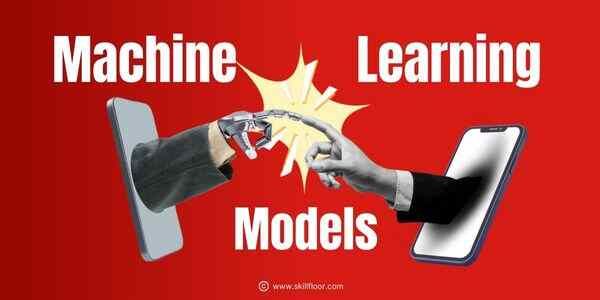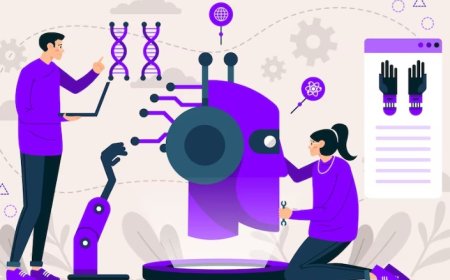Introduction to Machine Learning Models
Explore machine learning models, their types, applications, challenges, and best practices for building effective AI systems that transform industries.

When I first started learning about artificial intelligence (AI), I was interested in machine learning (ML) models. At their core, ML models are like tools that learn from data to recognize patterns and make predictions. Think of it like teaching a child to recognize objects by showing them examples. Similarly, ML models learn by looking at lots of data.
Today, ML models have gone from being just interesting academic ideas to powerful tools used in everyday life. They’re used in finance to predict stock market trends, in healthcare to find diseases in medical scans, and even in social media to recommend posts and videos. But to really understand how ML models work, it’s important to know the different types, how they learn, and why they’re so important in making smart decisions.
Types of Machine Learning Models
Machine learning (ML) models are algorithms or statistical models used to enable systems to learn patterns and insights from data and make decisions or predictions without being explicitly programmed. Here is a broad overview of various types of ML models and their key characteristics:
1. Supervised Learning Models
Description: These models learn from labeled data, meaning each input comes with a corresponding output. The algorithm tries to learn the mapping between inputs and outputs.
Examples
-
Linear Regression: Used for predicting continuous values (e.g., predicting house prices based on features like square footage).
-
Logistic Regression: Used for binary classification (e.g., determining if an email is spam or not).
-
Decision Trees: Predict a target value by learning simple decision rules inferred from data features.
-
Support Vector Machines (SVM): Finds a hyperplane in an N-dimensional space that distinctly classifies data points.
-
Neural Networks: Inspired by the structure of the human brain, these are powerful for capturing complex patterns in data.
2. Unsupervised Learning Models
Description: These models work with unlabeled data, learning patterns, and structure without knowing the outcomes in advance.
Examples:
-
Clustering (e.g., K-Means): Groups data into clusters based on similarity.
-
Principal Component Analysis (PCA): Reduces the dimensionality of data while retaining important features, useful for visualization or noise reduction.
-
Autoencoders: Neural networks used for unsupervised learning, often applied in anomaly detection or data compression.
3. Semi-Supervised Learning Models
Description: Combines a small amount of labeled data with a large amount of unlabeled data. This approach is useful when labeling is expensive or time-consuming.
Example: In image recognition, a small labeled dataset of images may be used alongside a large set of unlabeled images to improve classification performance.
4. Reinforcement Learning Models
Description: These models learn by interacting with an environment, and receiving rewards or penalties based on their actions. The goal is to maximize cumulative rewards.
Examples:
-
Q-Learning: A model-free algorithm that seeks to find the best action to take given the current state.
-
Deep Q-Networks (DQN): Combines Q-learning with deep learning to handle complex state spaces.
-
Proximal Policy Optimization (PPO): Commonly used in training AI for games and robotics.
5. Deep Learning Models
Description: These are a subset of machine learning models based on artificial neural networks with many layers. They excel at handling large, unstructured datasets like images, text, and audio.
Examples:
-
Convolutional Neural Networks (CNN): Designed for image and spatial data processing.
-
Recurrent Neural Networks (RNN): Used for sequential data such as time series or natural language processing (NLP).
-
Transformer Models: Revolutionized NLP tasks; the architecture behind models like BERT and GPT.
6. Ensemble Models
Description: These combine the predictions from multiple models to improve accuracy and robustness.
Examples:
-
Random Forest: An ensemble of decision trees, often used for both classification and regression tasks.
-
Gradient Boosting Machines (GBM): Sequentially builds models that correct the errors of previous models, used in libraries like XGBoost, LightGBM, and CatBoost.

Common Applications
-
Predictive Analytics: Forecasting trends and behaviors.
-
Natural Language Processing: Language translation, text generation, sentiment analysis.
-
Image Recognition: Identifying objects, facial recognition.
-
Recommender Systems: Suggesting products or content based on user preferences.
Each type of ML model has strengths and weaknesses, and the choice depends on the nature of the problem, data characteristics, and computational resources available.
Core Components and Concepts of Machine Learning Models
While exploring machine learning, I realized that building effective models isn’t just about choosing an algorithm; it’s about understanding the core concepts and components that make these models work.
-
Data: Data is the lifeblood of any model. Training data helps the model learn patterns, while test data evaluates its performance. I often emphasize data preprocessing to ensure quality inputs by handling missing values, scaling, and encoding categorical variables.
-
Features and Labels: Features are input variables used for predictions, while labels are output values. In a customer churn model, for example, customer age and spending patterns are features, while whether the customer churns is the label.
-
Training Process: Training involves feeding data through the model and adjusting internal parameters (weights) to minimize errors. Algorithms like gradient descent automate these adjustments, making learning efficient.
-
Loss Functions: These measure the difference between predicted and actual values. For me, selecting the right loss function (e.g., Mean Squared Error for regression) is key to accurate predictions.
Common Algorithms and Model Examples
When it comes to choosing algorithms, there’s no one-size-fits-all. Over time, I’ve learned to match algorithms to the problem at hand:
-
Linear Regression and Logistic Regression: Useful for straightforward regression and binary classification tasks.
-
Decision Trees and Random Forests: Decision trees are interpretable and split data based on features, while Random Forests use multiple trees to improve prediction accuracy.
-
Support Vector Machines (SVMs): These find the best boundary (hyperplane) to separate data classes, performing well with clear margins.
-
Neural Networks: From shallow to deep, these have grown in sophistication and power. I’ve used neural networks for complex pattern recognition and tasks like image classification.
-
Ensemble Models: Combining models like Random Forests and Gradient Boosting Machines (GBM) has been useful for increasing robustness.
Model Evaluation Metrics
Training a model is only half the battle; evaluating its performance is crucial. I use different metrics depending on the task:
-
Classification Metrics: Precision, recall, accuracy, and F1-score help me understand how well the model identifies true positives while avoiding false positives and negatives.
-
Regression Metrics: Mean Squared Error (MSE), Root Mean Squared Error (RMSE), and Mean Absolute Error (MAE) guide me in assessing how close predictions are to actual values.
-
ROC-AUC Score: For binary classification, I’ve found the Area Under the Receiver Operating Characteristic Curve (ROC-AUC) useful in evaluating how well the model discriminates between classes.
Overfitting and underfitting are challenges that surface during model evaluation. Overfitting happens when a model learns noise, while underfitting means it’s too simple to capture data patterns. Techniques like cross-validation and regularization have helped me maintain a balance.
Applications and Use Cases
Machine learning models have found applications across industries. Here are some use cases that I’ve found inspiring:
-
Healthcare: Models analyze medical images, predict diseases, and optimize treatment plans.
-
Finance: Fraud detection models identify unusual patterns in transactions, preventing financial crime.
-
Retail and Marketing: Recommender systems tailor customer experiences by suggesting products based on past interactions.
-
Natural Language Processing (NLP): Chatbots, sentiment analysis, and language translation exemplify how ML models revolutionize human-computer interactions.
Challenges in Machine Learning Models
Despite their potential, building and deploying machine learning models isn’t without challenges. Some key issues I’ve encountered include:
-
Data Quality: Garbage in, garbage out. Ensuring data is clean and unbiased is crucial. Missing values, outliers, and imbalanced datasets can skew results.
-
Bias and Fairness: Bias in training data can lead to biased models. For instance, a facial recognition system may perform poorly if trained on limited demographics.
-
Interpretability: Explaining why a model made a specific prediction is challenging, especially with complex deep-learning models.
-
Computational Costs: Training large models requires significant computational power. I’ve had to balance accuracy with resource constraints.
-
Deployment: Ensuring a model works in real-world environments often involves retraining and adapting to new data.
Emerging Trends in Machine Learning Models
Staying updated with emerging trends keeps me excited about this field. Some noteworthy trends include:
-
Transfer Learning: Leveraging pre-trained models to solve related tasks with minimal data.
-
Federated Learning: Training models across distributed devices while maintaining data privacy.
-
Explainable AI (XAI): Developing methods to make complex models interpretable and understandable.
-
AI Ethics and Governance: Addressing ethical implications and ensuring responsible AI development.
Best Practices for Developing Machine Learning Models
To wrap up, here are some practices I’ve adopted to develop and deploy effective machine-learning models:
-
Data Preprocessing: Cleaning, normalizing, and transforming data for better model performance.
-
Feature Engineering: Creating relevant features to enhance predictive accuracy.
-
Model Selection and Hyperparameter Tuning: Experimenting with different models and optimizing parameters to improve performance.
-
Regularization Techniques: Using L1 and L2 regularization to prevent overfitting.
-
Monitoring and Maintenance: Continuously monitor model performance post-deployment and retrain when necessary.
Machine learning models have become essential tools in transforming industries and reshaping how we interact with technology. Understanding their types, components, and applications, along with tackling challenges and adopting best practices, empowers me—and all of us who work in AI—to push the boundaries of what these models can achieve. I believe that by continually learning and adapting, we can unlock even greater potential for machine learning in the future.






























































